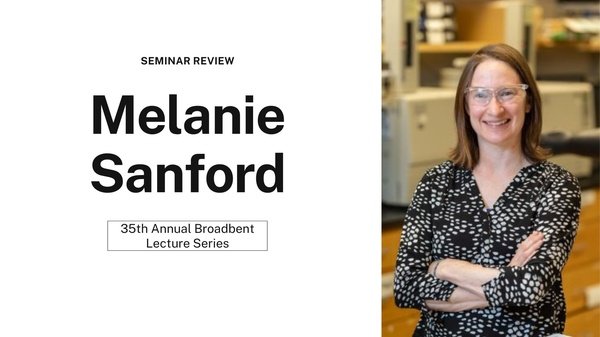35th Annual Broadbent Lecture Series with Melanie Sanford: Review
Feb. 9, 2023

Why do we care about electrical energy storage? What does the future of renewable energy look like? How are scientists racing to keep up with ever-increasing energy consumption rates?
On January 26, 2023, Melanie Sanford - Ph. D, recipient of the Moses Gomberg and Arthur F Thurnau distinctions and speaker for the 35th Annual Broadbent Lecture Series - addressed these questions with a group of students at Brigham Young University.
A professor at the University of Michigan and director of The Sanford Group, Sanford specializes in a myriad of chemical research areas, including biochemistry, inorganic studies, and sustainable methods. Sanford combined these topics at this year’s Broadbent Lecture to discuss ways in which her lab is contributing to the sustainability of renewable energy, particularly in storing renewable energy intake to be used and processed at a later time.
In 2019, only 11% of the energy consumed in the United States was renewable; of that 11%, most of it originated from biomass or hydroelectric plants. While solar usage has increased by 300% from 2019, Sanford cautions that there could be significant consequences to such mass burning of fossil fuels, and, while the country is getting on track to a more sustainable future, she says there are still areas in which the country can improve.
“So,” one might ask, “why don’t we just put up more wind turbines and solar panels?” While this is a positive start, Sanford explains that wind turbines and solar panels, as the world currently knows them, are vastly limited by an inconsistency in wind reliability and the continual need for electrical power at night. To make renewable energy a more reliable and widely accessible resource, Sanford states that scientists must increase the effectiveness of solar and wind energy. The way to do this, she says, is to improve the development of wind and solar powered batteries on a massive scale. Doing so would allow the energy captured at inconsistent intervals to be stored, preserved, and reallocated according to population needs. The whims of nature would no longer put limitations on human harnessing of elemental energy.
Currently, according to Sanford, wind and solar farms are using massive redox flow batteries in an attempt to store renewable energy. Redox batteries contain electrochemical cells with completely inert electrodes. Molecular energy flows into the electrochemical cell, undergoes an oxidation process, then travels along an interior circuit. These oxidized molecules are reduced to form anions, which flow out of the electrochemical cell into an anloyte reservoir. These molecules are stored in the reservoir chamber, whereupon the process can be reversed and usable energy can be extracted. While this battery is currently in use and has prototypes across the United States, it is severely limited in energy capacity and take up massive amounts of space.
One of the reasons these batteries are so limited in energy capacity, Sanford says, is because of the use of aqueous solutions. As water can only hold and react to so much, this, in turn, limits the amount of energy that can be stored. To make these battery solutions more effective, Sanford describes that Vanadium was considered as a substitute in catholyte solution. However, Vanadium is an elemental rarity, not earth-abundant enough to be a long-term answer to the battery capacity problem.
Thus, Sanford proposes that scientists need the following: “Molecules with reversible redox processes [and] molecules with high energy density.” The higher a molecule’s energy density, the greater volume of energy it can contain. In her lecture, Sanford compares this concept to the evolution of smartphones; once heavy, brick-like cell phones have been redesigned to be sleek, thin, and more powerful. This is because modern cell phone batteries have higher energy density, and this is the same goal for which Sanford and her team are striving.
To contribute to this field of research, Sanford and her students are experimenting with changing solution solubility, collaborating with the Department of Energy and the Joint Center for Energy Storage Research, and examining solution regressions and decomposition rates in conjunction with isopropyl’s effect on static cycling. Using physical organic chemistry, the Sanford Group’s goal is to “create next generation electrolytes [to uncover] fundamental science behind key properties;” Sanford reports that her lab is hoping, within the next couple of years, to make and apply breakthroughs that will surpass the knowledge currently available to the scientific community.
To learn more about Sanford, her research, or her research group, please visit her faculty website at https://lsa.umich.edu/chem/people/faculty/mssanfor.html.